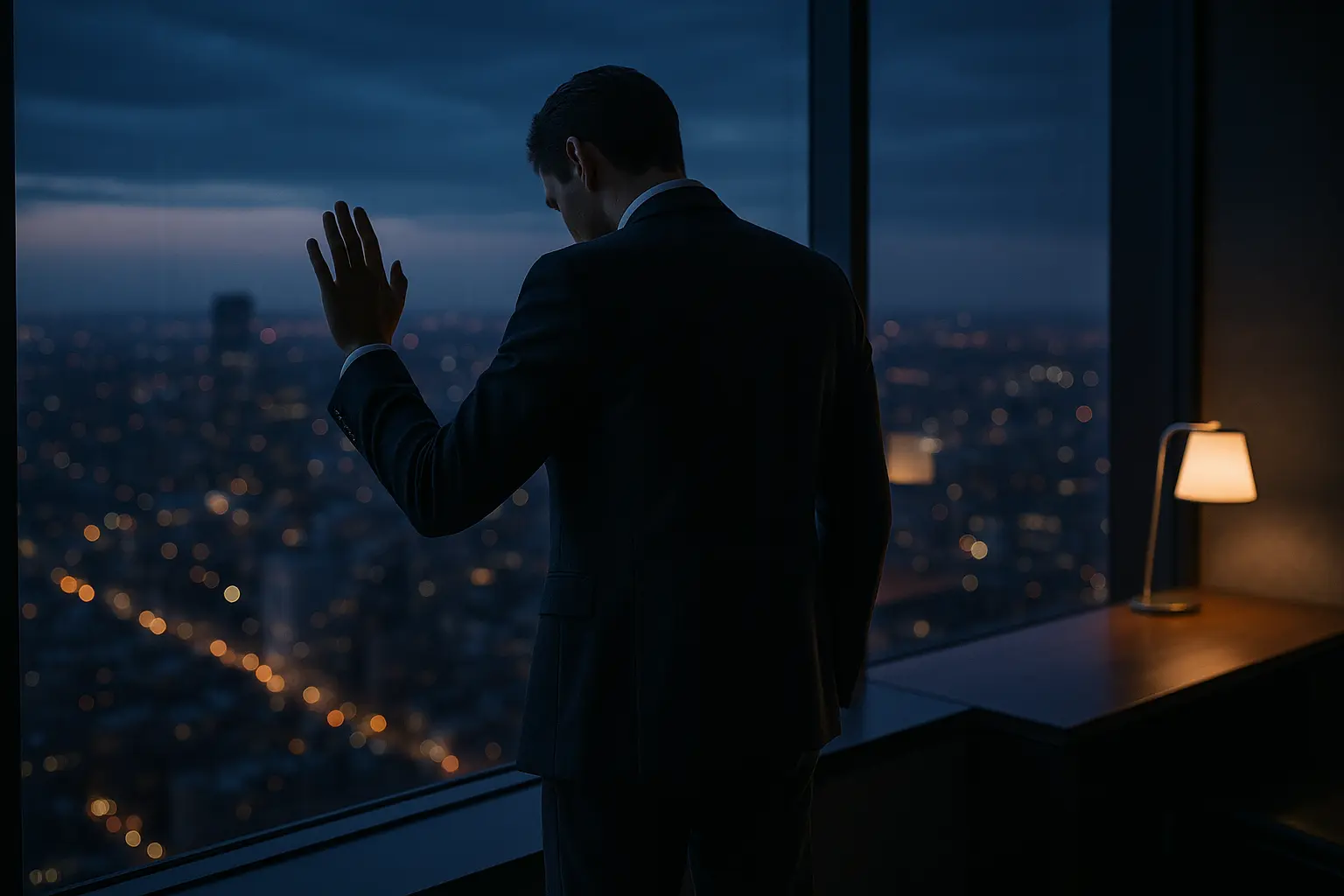
The CEO Burnout: A Hidden Threat to Your Leadership
Key Takeaway: CEO burnout, recognized by the WHO as a syndrome linked to chronic stress, is not a sign of weakness but the result of extreme pressure. According to a Swedish study, it affects both the leader’s health and the company’s performance. In France, 48% of business leaders report feeling more stressed since the COVID-19 pandemic, highlighting the urgency of addressing this silent risk.
Is CEO burnout silently eroding your leadership without you realizing it? Discover how chronic stress can transform an inspiring leader into a shadow of themselves—undermining decision-making and contaminating the entire team. Drawing on insights from the WHO and resilience experts, this guide reveals practical strategies to avoid burnout, rebalance your energy, and redefine sustainable leadership without sacrificing ambition. Ready to turn exhaustion into renewed strength while protecting your company’s health?
1- CEO Burnout: More Than Just Stress — A Silent Threat to Your Leadership
2- Warning Signs of Burnout: Listen to Your Body and Mind
3- Why Are Leaders So Vulnerable? The Root Causes of Burnout
4- The Impact of a Burned-Out CEO: When the Leader Falters, the Company Shakes
5- Building Resilience: Proactive Strategies to Prevent Exhaustion
6- Taking Action Against Burnout: How to Regain Your Drive and Leadership
7- Toward Sustainable Leadership: Redefining Success Beyond Performance

CEO Burnout: More Than Just Stress — A Silent Threat to Your Leadership
As a leader, you might believe you can ignore your body’s signals. The WHO classifies burnout as an occupational syndrome. Being “alone at the top” doesn’t protect you from a phenomenon that can affect your entire organization.
The Loneliness at the Top — An Underestimated Risk
How many nights do you spend silently replaying decisions? According to a Vistage study, 75% of leaders lack support. The “superhero syndrome” becomes a dangerous trap.
Chronic Stress vs. Burnout — Understanding the Decline
Stress is inevitable, but when it persists, it destroys efficiency. Exhaustion, mental detachment, and reduced performance form the burnout triad (WHO). Leading with an empty tank may be your current reality.
Recognizing the Signs Before Breaking Down
Do your responsibilities feel increasingly heavy? Do decisions that once felt easy now seem overwhelming? Since the COVID-19 pandemic, 48% of business owners report higher stress levels. Economic uncertainty (44%) further amplifies the risk.
The Impact on the Company — When the Leader Falters
Your exhaustion spreads to your team. Harvard Business Review reports a 26% drop in team cohesion. Your irritability creates a toxic atmosphere.
Prevention — Building a Shield Against Exhaustion
- Non-negotiable daily disconnection
- Trusted circle to share challenges
- Delegation of operational tasks
- Physical activity to regulate stress
- Optimized work environment
Trust Network — Your Early Warning System
A seasoned mentor is key. Forbes notes that mentored leaders reduce their risk of burnout by 40%. Your network becomes your radar.
Warning Signs of Burnout: Listen to Your Body and Mind
Psychological and Behavioral Symptoms
As a leader, have you ever felt unusual mental fatigue or lost confidence in your decisions? 94% of SME leaders have experienced these symptoms. Here are the signs not to ignore:
- Persistent loss of motivation and sense of purpose
- Feeling constantly overwhelmed and unable to manage everything
- Increasing isolation and withdrawal from social interactions
- Doubting your own skills and strategic vision
- Difficulty making clear decisions
Frequent irritability and mood swings reflect unmanaged stress. The loss of strategic vision, combined with a cynical attitude toward projects, erodes enthusiasm. These signs—such as difficulty delegating or disengagement—threaten not only your health but also your company’s stability. A burned-out CEO risks spreading anxiety to the team, creating a collective stress climate.

Physical Symptoms You Shouldn’t Ignore
Your body sends warnings your mind refuses to hear. Chronic fatigue, even after vacations, is a red flag. Back pain, migraines, and digestive issues signal constant tension. These symptoms often appear before psychological ones, acting as the “canary in the coal mine.”
Night awakenings and sudden weight changes point to a weakened immune system. If you’re catching colds more frequently, your body is warning you: exhaustion is threatening your health. Physical symptoms are objective indicators—unlike subjective feelings. For instance, daily migraines can reduce your ability to focus on strategic matters by 40%.
Ignoring these signs can lead to serious consequences such as strokes or depression. In 2019, 17.5% of business leaders in France were at risk of burnout. The pandemic exacerbated the situation, with 48% of respondents reporting increased stress. Your well-being determines your company’s sustainability—a burned-out CEO makes 32% more wrong decisions, according to the 2024 Vistage study.

Why Are Leaders So Vulnerable? The Root Causes of Burnout
Isolation at the Top and Constant Pressure
The feeling of isolation is one of the primary triggers of burnout. Leaders often hesitate to share their struggles with their teams or shareholders, creating a critical relational void. According to a study, 45% of SME and mid-size company executives felt isolated in 2016 — a number that rose to 55% in 2024 when it comes to mental health concerns.
Pressure intensifies with total responsibility, encompassing strategic decisions, financial stability, and employee well-being. The pandemic exacerbated this issue: 48% of business owners reported increased stress, with economic uncertainty (44%) being a significant trigger. The lack of fundamental disconnection blurs the line between work and personal life, as urgent calls and late-night meetings take over.
Psychological Dependence on Pressure
Some leaders develop an actual addiction to stress, subconsciously seeking high-intensity situations. This “professional adrenaline” activates the brain’s dopamine circuits, making short-term achievements addictive. The “superhero syndrome” pushes them to believe they must handle everything alone, stretching their limits until exhaustion.
This reactive mechanism harms strategic clarity. Leaders trapped in this cycle are 3.5 times more likely to leave their position prematurely. According to the DDI 2025 report, 71% of global leaders experience higher stress levels since taking office. The challenge is to shift from reactive management to intentional leadership by setting clear boundaries and valuing resilience as a performance driver.
The Role of Organizational Structures
The expectations of boards and investors generate structural stress. Quarterly reports, short-term goals, and a culture of instant performance turn leadership into a continuous sprint. One study shows that boards often underestimate CEO burnout when financial indicators remain positive.
This institutional pressure has serious consequences: 60% of burned-out CEOs create toxic environments, affecting 60% of their teams through sarcasm, negativity, or emotional withdrawal.
Organizations must evolve by implementing:
- 360° feedback systems,
- Safe reporting policies,
- And a culture of empathy and mental health awareness,
As key tools for strategic prevention.
The Impact of a Burned-Out CEO: When the Leader Falters, the Company Trembles
A burned-out CEO can unknowingly become the company’s most significant risk factor. According to a Swedish study involving 156 executives, a high level of exhaustion leads to a significant drop in performance, especially in large companies where the CEO’s influence is amplified. This phenomenon arises from structural complexity — decisions made at the top cascade throughout the organization, magnifying the impact of mistakes.
Exhaustion compromises decision-making clarity: leaders swing between impulsive actions and paralysis. Depersonalization, a core symptom of burnout, stifles constructive dialogue, halts innovation, and reinforces the status quo. Teams suffer from tension, low morale, absenteeism, and decreased productivity — all of which damage the company’s reputation. A well-known example is Air France, where hasty decisions under pressure regarding safety exposed the vulnerability of an exhausted leadership. Emotional exhaustion, depersonalization, and the sense of personal failure — the three dimensions of burnout — erode a leader’s ability to handle critical challenges.
| Aspect | Thriving CEO | Burned-out CEO |
|---|---|---|
| Decision-making | Clear and thoughtful decisions | Erratic or paralyzed decisions |
| Strategic vision | Inspiring long-term vision | Blurred and short-term vision |
| Company culture | Culture of trust and collaboration | Culture of mistrust and micromanagement |
| Team performance | Engaged and productive teams | Demotivated and stressed teams |
| Innovation | Encourages creativity | Stifles innovation and fosters fear of failure |
Large organizations are particularly vulnerable: their complexity limits the CEO’s agility, amplifying the effects of burnout. However, resource availability and shared responsibility, such as splitting the roles of CEO and Board Chair, can mitigate these risks. These factors strengthen the leader’s ability to delegate and refocus on strategic priorities — as shown in a ScienceDirect study.
Building Resilience: Proactive Strategies to Prevent Burnout
Integrating “Performance Maintenance” Rituals
Resilience is built through minor, consistent daily optimizations. These rituals help manage your energy strategically by aligning complex tasks with your natural peaks of focus. Here are three key levers:
- Strategic Timeboxing: Work in 90-minute blocks of intense concentration, followed by a short break. This method aligns with the brain’s natural rhythm, optimizing decisions while preventing exhaustion. Ninety minutes correspond to the ultradian rhythm — the period during which our attention is at its best. Structuring your schedule around these cycles prevents mental scattering and maximizes the quality of your decisions, especially for critical choices.
- Micro Recovery Breaks: Take real 5- to 10-minute breaks (without screens) to reset your mind. Simple techniques, such as deep breathing, brisk walking, or a 2-minute mindfulness exercise, can help restore mental clarity. Studies have shown that these pauses lower cortisol levels, reduce stress, and improve working memory.
- Weekly Debrief Ritual: Set aside one hour each week to evaluate successes, challenges, and priorities. This helps strike a balance between urgency and strategic vision. Useful tools include the Eisenhower Matrix to distinguish between urgent and important tasks, as well as a personal SWOT analysis to identify key levers for improvement.
These seemingly simple practices create a sustainable rhythm. They turn a marathon into controlled sprints, conserving energy for the critical challenges ahead.
The Fundamentals: Sleep, Exercise, and Disconnection
The basics are often overlooked, yet they are strategic. Jeff Bezos considers his eight hours of sleep a responsibility toward shareholders. Why? A well-rested mind makes higher-quality decisions — essential for the company’s future. Arianna Huffington, founder of The Huffington Post, embraced this philosophy after narrowly avoiding burnout. She emphasizes that sleep enhances creativity and strategic clarity.
Physical exercise can become a valuable stress management tool. A brisk walk or a yoga session can calm anxiety. Leaders like Jack Dorsey have adopted meditation to strengthen mental resilience. Finally, total disconnection — no phone, no email — rejuvenates the brain. Research indicates that information overload can reduce productivity by 28%. A leader who disconnects sets a healthy example for their teams.
Want to structure these habits? Our business coaching services offer a personalized framework. Professional guidance helps identify areas for improvement, build tailored routines, and maintain motivation, as preventing burnout is an investment in the sustainability of both your leadership and your business.
Taking Action Against Burnout: How to Regain Momentum and Leadership
Acceptance and Action: The First Steps Toward Recovery
Recognizing your state is the first step. Your health deserves as much attention as your business: consult a physician to assess your physical and emotional symptoms. This professional may refer you to a psychologist if needed.
The signs are clear — difficulty making decisions, loss of motivation, restless nights. These symptoms are not signs of incompetence, but rather warning signals to heed. Take short but regular breaks to recharge your mind. Your leadership will grow stronger as a result.
Delegating, Trusting, and Refocusing
Delegation is a strategic act of leadership. Here are the key steps:
1- Take stock: Identify repetitive tasks that can be delegated to team members or external partners.
2- Communicate: Inform your team and close circle about your situation to gain tangible support.
3- Set realistic goals: Focus on the 20% of activities that generate 80% of results.
4- Reconnect with your instincts: Relearn to listen to your intuition to regain strategic clarity.
The Importance of External Support: Don’t Stay Isolated
Leaders who isolate themselves face a higher risk of burnout. A mentor or peer group provides an external perspective. Working with a business coach can provide you with the tools to navigate this period and strengthen your leadership.
Executive coaching, as proven by research, helps reduce burnout symptoms while restoring a work-life balance. Techniques such as mindfulness help regain energy and resilience in the face of daily challenges.
Toward Sustainable Leadership: Redefining Success Beyond Performance
CEO burnout is not a sign of weakness but a warning signal: the leadership model built on personal sacrifice is unsustainable. Resilience is now a strategic competency. Taking care of your health is an investment in the company’s most valuable asset — its leader.
48% of business leaders report feeling more stressed since the pandemic. An exhausted CEO makes poorer decisions, disengages team members, and slows down growth. Sustainable success is measured by one’s ability to maintain physical energy, mental clarity, and alignment with personal values.
Inspiring leadership rests on four pillars: restorative sleep, emotional regulation, balanced relationships, and alignment with one’s mission. Setting boundaries, delegating tasks, and maintaining a healthy lifestyle are not concessions, but rather levers for enhanced performance.
A resilient leader prioritizes morning meditation, family dinners, or regular talks with a mentor. These choices lay the foundation for a company culture that fosters a balance between well-being and excellence.
Ready to redefine your leadership? Identify your warning signs — fatigue, irritability, or loss of vision. Together, let’s build a roadmap that combines performance and sustainability. Your energy determines tomorrow’s growth.
CEO burnout is not inevitable — it’s a wake-up call. By reinventing your approach to leadership — embedding well-being and resilience at the heart of your priorities — you transform your energy into sustainable, high-performance outcomes. Are you ready to redefine success for lasting impact?




